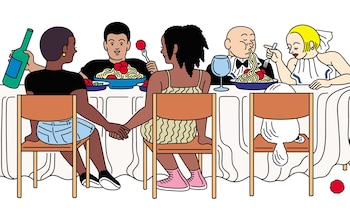Growing up, 52-year-old Mary Harris from Texas always felt she didn't quite fit in with her sisters. Their blonde hair and blue eyes contrasted with her own darker features.
Driven by curiosity, she asked for an at-home DNA test for Christmas in 2022. But the 23andMe test that arrived on a quiet Saturday night would turn her life upside down.
It revealed that her sisters were, in fact, half sisters. She also discovered three half brothers and one half sister she had never known about.
"I was totally shocked," Harris told Newsweek.
The test also helped her identify her biological father, who had sadly passed away in 2017, long before she could meet him.
Her mother died in a car accident in 1980, leaving Harris without anyone to explain the secrets of her past.
But the revelation of the DNA test was less of a surprise and more of a confirmation for Harris. Growing up, the differences between her and her sisters were always apparent.
"I was always told that I looked just like our mom," she recalled, but the man listed on her birth certificate, her sisters' father, never felt like her own.
"He passed away in 1979, and my mom divorced him when I was about two years old," she said.
At-home DNA tests have experienced a surge in popularity in recent years, giving the general public a quick and easy way to get an insight into their own ancestry, health and genetics. An affordable posted test asks simply for a saliva sample or cheek swab and is able to offer a host of information about an individual.
By early 2019, more than 26 million people had taken at-home ancestry tests, with the number expected to grow further still as more people look for answers about their own genetics.
Harris said she is glad she took the 23andMe test.
"I was out here in the world just wondering, so I am very grateful," she said.
A newly discovered half brother, who also used the service, confirmed their connection, solidifying the accuracy of her results.
While many home DNA tests simply give people a little extra glimpse into their ancestry, discovering family secrets isn't uncommon either.
Andy Kill, a spokesperson for 23andMe, told Newsweek that discoveries like Harris' are increasingly common.
"With genetic testing readily available, we're hearing more stories of families discovering and reuniting with newfound relatives," he said.
The company's DNA Relatives tool, which Harris used to connect with her half brother, helps people find and connect with genetic relatives, though customers are informed that they may uncover unexpected relationships.
In addition to finding new family members, Harris's DNA results revealed something about her deep ancestry: she has more Neanderthal DNA than most other people.
"I had 89 percent more Neanderthal DNA than other 23andMe users," she said, a discovery that sparked an interest in the ancient past. "The Neanderthals roamed the earth about 30,000 years ago, and to find myself with their DNA is incredible."
Man's DNA ancestry test produces shock results: "Not sure how normal it is"Read more Man's DNA ancestry test produces shock results: "Not sure how normal it is"Neanderthals, scientifically known as Homo neanderthalensis, are an extinct group of archaic humans. While different from Homo sapiens, the two species had more in common than originally thought, according to a recent study published in the Journal of Archaeological Method and Theory.
The study discovered parallels between how Neanderthals and early modern humans made use of space in their dwellings, using sites as temporary bases and moving around as mobile hunter-gatherers, rather than making permanent homes.
This commonality between the two suggests that they shared comparable cognitive abilities for spatial organization, despite earlier theories that the cognitive capacity and behavioral complexity of Neanderthals was less than homo sapiens.
Kill explained that 23andMe tests for thousands of markers across the genome, including Neanderthal DNA.
"Our Neanderthal Ancestry Report is one of our most engaging features," he said, providing customers with insights into their ancient human ancestry.
According to the Smithsonian Institution, Neanderthals are known to contribute 1-4% of the genomes of non-African modern humans, so Harris' discovery is nothing out of the ordinary, although she has more Neanderthal DNA than most.
Genetic testing has given Harris a true insight into her past, connecting her with lost family members and linking her to ancient lineage. Despite all the surprises, she is pleased that she did it.
"Through all of this, I am very strong and believe all the turmoil made me who I am today," she said.
Disclaimer: The copyright of this article belongs to the original author. Reposting this article is solely for the purpose of information dissemination and does not constitute any investment advice. If there is any infringement, please contact us immediately. We will make corrections or deletions as necessary. Thank you.



